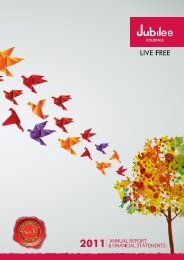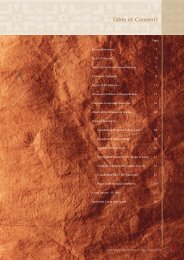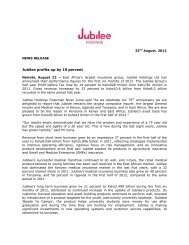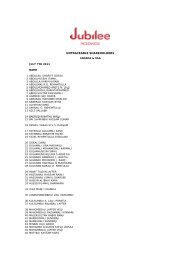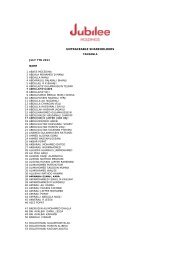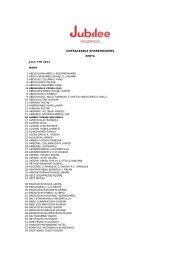Jubilee Insurance 2010 Annual Report
Jubilee Insurance 2010 Annual Report
Jubilee Insurance 2010 Annual Report
Create successful ePaper yourself
Turn your PDF publications into a flip-book with our unique Google optimized e-Paper software.
JUBILEE HOLDINGS<br />
ANNUAL REPORT AND FINANCIAL STATEMENTS<br />
FOR THE YEAR ENDED 31 ST DECEMBER <strong>2010</strong><br />
25<br />
NOTES (continued)<br />
2. Summary of significant Accounting Policies (continued)<br />
2.5 Investment Contracts<br />
The Group issues investment contracts with fixed and guaranteed terms<br />
(fixed interest rate). The investment contracts include funds administered<br />
for a number of retirement benefit schemes.<br />
For investment contracts with fixed and guaranteed terms, the amortised<br />
cost basis is used. In this case, the liability is initially measured at its fair<br />
value less transaction costs that are incremental and directly attributable<br />
to the acquisition or issue of the contract.<br />
Subsequent measurement of investment contracts at amortised cost uses<br />
the effective interest method. This method requires the determination of<br />
an interest rate (the effective interest rate) that exactly discounts to the<br />
net carrying amount of the financial liability, the estimated future cash<br />
payments or receipts through the expected life of the financial instrument<br />
or, when appropriate, a shorter period if the holder has the option to<br />
redeem the instrument earlier than maturity.<br />
The Group re-estimates at each reporting date the expected future cash<br />
flows and recalculates the carrying amount of the financial liability by<br />
computing the present value of estimated future cash flows using the<br />
financial liability’s original effective interest rate. Any adjustment is<br />
immediately recognised as income or expense in the profit and loss<br />
account.<br />
Subsequent costs are included in the asset’s carrying amount or recognised<br />
as a separate asset, as appropriate, only when it is probable that future<br />
economic benefits associated with the item will flow to the Group and<br />
the cost of the item can be measured reliably. All other repairs and<br />
maintenance are charged to the income statement during the financial<br />
period in which they are incurred.<br />
Depreciation on other assets is calculated using the straight line method<br />
to write down their cost to their residual values over their estimated useful<br />
lives, as follows:<br />
Computers<br />
Office equipment<br />
Motor vehicles<br />
Furniture, fixtures and fittings<br />
3 years<br />
4 years<br />
5 years<br />
10 years<br />
The assets’ residual values and useful lives are reviewed, and adjusted if<br />
appropriate, at each reporting date.<br />
An asset’s carrying amount is written down immediately to its estimated<br />
recoverable amount if the asset’s carrying amount is greater than its<br />
estimated recoverable amount.<br />
Gains and losses on disposal of property and equipment are determined<br />
by reference to their carrying amount and are included in the profit and<br />
loss account.<br />
2.6 Revenue Recognition<br />
(i) <strong>Insurance</strong> premium revenue<br />
The revenue recognition policy relating to insurance contracts is set out<br />
under note 2.4 (b) i).<br />
(ii) Non interest income from financial investments<br />
The revenue recognition policy for non interest income from financial<br />
investments is disclosed in note 2.10<br />
(iii) Interest income and expenses<br />
Interest income and expense for all interest-bearing financial instruments,<br />
including financial instruments measured at fair value through profit or<br />
loss, are recognised within ‘investment income’ and ‘finance costs’ in<br />
the income statement using the effective interest rate method.<br />
(iv) Dividend income<br />
Dividend income for available-for-sale equities is recognised when the<br />
right to receive payment is established – this is the ex-dividend date for<br />
equity securities.<br />
(v) Rental income from investment properties<br />
Rental income is recognised in the period it is earned.<br />
(vi) Commission earned<br />
The revenue recognition policy on commission is disclosed in note 2.4<br />
(b) iii).<br />
2.7 Property and Equipment<br />
All categories of property and equipment are initially recorded at cost.<br />
Property and equipment are stated at historical cost less depreciation.<br />
Historical cost includes expenditure that is directly attributable to the<br />
acquisition of the items.<br />
2.8 Investment Property<br />
Buildings, or part of a building, (freehold or held under a finance lease)<br />
and land (freehold or held under an operating lease) held for long term<br />
rental yields and/or capital appreciation and are not occupied by the<br />
Group are classified as investment property. Investment property is carried<br />
at fair value, representing open market value determined annually by<br />
external valuer’s. Changes in fair values are included in investment<br />
income in income statement.<br />
2.9 Intangible Assets<br />
(i) Goodwill<br />
Goodwill represents the excess of the cost of an acquisition over the<br />
fair value of the Group’s share of the net identifiable assets of the<br />
acquired subsidiary/associate at the date of acquisition. Goodwill on<br />
acquisitions of subsidiaries is included in intangible assets. Goodwill<br />
on acquisitions of associates is included in investments in associates.<br />
Goodwill is tested annually for impairment and carried at cost less<br />
accumulated impairment losses. Gains and losses on disposal of an<br />
entity include the carrying amount of goodwill relating to the entity sold.<br />
Goodwill is allocated to cash-generating units for the purpose of<br />
impairment testing. Each of those cash-generating units represents the<br />
Group’s investment in each country of operation by each reporting<br />
segment. There was no goodwill balance at the end of <strong>2010</strong> and 2009.<br />
(ii) Computer software<br />
Acquired computer software licences are capitalised on the basis of<br />
the costs incurred to acquire and bring to use the specific software.<br />
These costs are amortised over their estimated useful lives (three to<br />
five years). Costs associated with developing or maintaining computer<br />
software programmes are recognised as an expense as incurred.<br />
Costs that are directly associated with the production of identifiable<br />
and unique software products controlled by the Group, and that will<br />
probably generate economic benefits exceeding costs beyond one<br />
year, are recognised as intangible assets. Direct costs include the<br />
software development, employee costs and an appropriate portion of<br />
relevant overheads. Computer software development costs recognised<br />
as assets are amortised over their estimated useful lives (not exceeding<br />
three years).<br />
JUBILEE HOLDINGS



